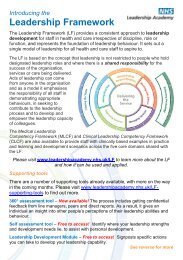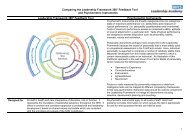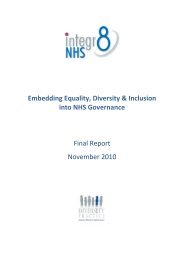team building work and there are some key principles we keep to
team building work and there are some key principles we keep to
team building work and there are some key principles we keep to
You also want an ePaper? Increase the reach of your titles
YUMPU automatically turns print PDFs into web optimized ePapers that Google loves.
Introduction <strong>to</strong> Team DevelopmentK<strong>are</strong>n Lynas, NHS Leadership AcademyHuge volumes have been given over <strong>to</strong> the discussion of what makes a good <strong>team</strong> <strong>and</strong> consequentlywhat kind of development interventions might best help your <strong>team</strong> make the necessary changes <strong>to</strong> movefrom being functional <strong>to</strong> being ‘high performing’. This short paper gives a very quick introduction <strong>to</strong><strong>some</strong> of the <strong>principles</strong> behind good <strong>team</strong> development, <strong>some</strong> important <strong>and</strong> common themes <strong>and</strong> a<strong>some</strong> examples of approaches that might be useful. Importantly it gives you <strong>some</strong> things <strong>to</strong> think about<strong>to</strong>gether before you embark on your own development <strong>and</strong> <strong>some</strong> pointers in finding a facilita<strong>to</strong>r who willprovide what you want.The paper has been written with contributions from the NHS Leadership Academy faculty, most of whom<strong>are</strong> able <strong>to</strong> provide the kind of facilitation you will need. Should you wish <strong>to</strong> discuss any of this <strong>work</strong>, ortalk about engaging with any of the faculty <strong>we</strong> <strong>work</strong> with, contact Dave Ash<strong>to</strong>n, who is our leadershipexpert in this <strong>are</strong>a.
Team DevelopmentHow <strong>we</strong> develop <strong>team</strong> <strong>work</strong>ing <strong>and</strong> <strong>team</strong>s across the NHS iscrucial <strong>to</strong> developing an organisational culture <strong>and</strong> sh<strong>are</strong>d senseof purpose, focussed on improving outcomes for patients.It is crucial in supporting how <strong>we</strong> blend the invaluable skills,capabilities, knowledge, experience <strong>and</strong> diversity of staff <strong>to</strong>develop a new culture <strong>and</strong> vision with clinical leadership, localism<strong>and</strong> public <strong>and</strong> patient participation at is heart.We know that this requires a shift in <strong>some</strong> of our behaviours, <strong>and</strong>maybe development of new skills, so that individuals <strong>are</strong> able <strong>to</strong><strong>work</strong> in multiple <strong>team</strong>s <strong>to</strong> deliver sh<strong>are</strong>d success.So whilst <strong>team</strong> development needs <strong>to</strong> be flexible <strong>and</strong> tailored <strong>to</strong>the needs of specific <strong>team</strong>s where ever they <strong>are</strong> <strong>and</strong> at whateverlevel they <strong>are</strong> operating , the broader frame of what <strong>we</strong> seek <strong>to</strong>achieve needs <strong>to</strong> set the <strong>to</strong>ne, <strong>and</strong> shape <strong>team</strong> developmentinterventions .We suggest that all <strong>team</strong> development interventions should have<strong>some</strong> implicit sh<strong>are</strong>d objectives <strong>to</strong>:• help reinforce from the outset the single organisation,concept, that each <strong>team</strong> is part of a wider single <strong>team</strong>• enable <strong>team</strong> members <strong>to</strong> support each other acrossdirec<strong>to</strong>rate boundaries <strong>to</strong> achieve the best outcomes forpatients <strong>and</strong> communities, the organisation <strong>and</strong> their <strong>team</strong>.• help reduce the potential for developing silo <strong>work</strong>ing, bydeveloping system thinking <strong>and</strong> underst<strong>and</strong>ing• maximise the opportunities <strong>to</strong> build open, inclusive,connecting <strong>team</strong> <strong>work</strong> which does not let boundaries get inthe way of doing the best for patients <strong>and</strong> the public• promote matrix <strong>work</strong>ing internally <strong>and</strong> with external partners• build strong ethical values <strong>and</strong> behaviours in line with theNHS Constitution• develop the culture, mind-sets <strong>and</strong> behaviours applicableacross your whole organisation
Introduction <strong>to</strong> <strong>team</strong>developmentOur definition – <strong>there</strong> is hardly an <strong>are</strong>a of <strong>team</strong> <strong>work</strong> <strong>and</strong> <strong>team</strong>development that isn’t open <strong>to</strong> contentious debate. This paperdoes not engage in nor indulge those debates but sh<strong>are</strong>s ourperspective <strong>and</strong> gives us a sh<strong>are</strong>d language <strong>to</strong> talk about <strong>team</strong>s.For the purposes of this <strong>work</strong> <strong>we</strong> describe a <strong>team</strong> as simply:a group of people who <strong>are</strong> <strong>work</strong>ing through collectiveendeavour <strong>to</strong>ward a common goal.This is useful for the NHS in that it allows a definition thatencompasses the many different <strong>team</strong>s that you might <strong>work</strong> withas part of your daily activities. Teams who <strong>are</strong> made up ofdifferent specialists who come <strong>to</strong>gether for specific pieces of<strong>work</strong> have no less need <strong>to</strong> develop <strong>team</strong> <strong>work</strong>ing behaviours asthose who <strong>work</strong> always as an intact <strong>team</strong>.For everyone <strong>work</strong>ing in the NHS the essential ingredients <strong>and</strong>desired qualities for effective <strong>team</strong> <strong>work</strong>ing <strong>are</strong> thesame: increased self-aw<strong>are</strong>ness <strong>and</strong> openness; listening;facilitating; empo<strong>we</strong>ring; the intelligent use of emotion <strong>and</strong>boundaries; reading multiple perspectives <strong>and</strong> creatively valuingdifference; increased curiosity <strong>and</strong> less rush <strong>to</strong> judgement; clarityaround accountability, responsibility <strong>and</strong> authority; skill in giving<strong>and</strong> receiving challenge <strong>and</strong> feedback; skill <strong>and</strong> regularity ofreview <strong>and</strong> reflection; <strong>to</strong>lerance of uncertainty; aw<strong>are</strong>ness ofown leadership style <strong>and</strong> the climate you create.The level of individual critical self-aw<strong>are</strong>ness is important withinan intact <strong>team</strong> <strong>and</strong> these behaviours <strong>are</strong> transferable <strong>to</strong> transient<strong>and</strong> task <strong>and</strong> finish <strong>team</strong>s. It might help <strong>to</strong> think about good <strong>team</strong><strong>work</strong>ing being made up of two component parts – the individualskills <strong>and</strong> behaviours of the component members of the <strong>team</strong><strong>and</strong> the alchemy of bringing those skills <strong>to</strong>gether. The former iscrucial in matrix <strong>work</strong>ing – seeing yourself as part of the wholeorganisation ‘<strong>team</strong>’ <strong>and</strong> <strong>there</strong>fore adopting the behaviours,attitudes <strong>and</strong> skills needed <strong>to</strong> <strong>work</strong> effectively <strong>and</strong> with integrityin whatever <strong>team</strong> you <strong>are</strong> <strong>work</strong>ing in at any one time. The latteris the <strong>work</strong> you will do with your ‘home’ <strong>team</strong> – the intact <strong>team</strong>that forms your principal set of colleagues <strong>and</strong> <strong>work</strong>ing partners.
Characteristics of good <strong>team</strong>developmentIt is important <strong>we</strong> identify what the behaviours will look likewhen people <strong>are</strong> consciously <strong>work</strong>ing in the context of the wholesystem rather than ‘their own bit’. Once the picture of what thisbehaviour looks like is clear, the outcomes <strong>and</strong> accountability for‘matrix <strong>and</strong> cross boundary <strong>work</strong>ing’ <strong>and</strong> ‘boundary-lessbehaviour’ can be more easily identified <strong>and</strong> measured; in otherwords <strong>we</strong> can get a clear sense of what is happening when matrix<strong>work</strong>ing is functioning really effectively with <strong>and</strong> for multiple<strong>team</strong>s.So for the purposes of informing <strong>team</strong> development <strong>there</strong> <strong>are</strong>three <strong>key</strong> points <strong>to</strong> note; A <strong>team</strong> <strong>work</strong>s with collective endeavour <strong>to</strong>ward a commongoal Members of the organisation will be a part of multiple <strong>team</strong>sincluding what they may regard as their home <strong>team</strong> Effective <strong>team</strong> <strong>work</strong>ing comprises two essential elements; self<strong>and</strong> <strong>team</strong> - effective <strong>team</strong> development <strong>work</strong>s on both ofthese elements.The focus of good <strong>team</strong> development will generally be aroundthe following:• How <strong>to</strong> get aligned <strong>and</strong> energised around a common purpose /vision /goal• Underst<strong>and</strong>ing / appreciating the different contributions from<strong>team</strong> members• How <strong>to</strong> make the most of the similarities / differences withinthe <strong>team</strong>• Developing skills for managing internal conflict
Characteristics of good <strong>team</strong>developmentArguably the most important element of <strong>team</strong> development is the quality of the individual conversations <strong>and</strong> relationships of trust thatindividual <strong>team</strong> members build with each other. If <strong>there</strong> is no trust <strong>there</strong> is no real challenge, support, innovation, performance <strong>and</strong> veryprobably no real sh<strong>are</strong>d purpose/goals or aims.The <strong>work</strong> you do before the <strong>team</strong> development starts is crucial <strong>and</strong> should include at least:Adequate preparation – not <strong>to</strong>o much, <strong>we</strong> <strong>are</strong> always conscious of people being time poorGood contracting – the <strong>team</strong> <strong>and</strong> the facilita<strong>to</strong>r must negotiate permission <strong>to</strong> challenge with positive intention, be open, honest. Oneimportant element of good contracting is discussing how you will h<strong>and</strong>le deviation from the contract. Sticking a lot of <strong>we</strong>ll-meaningwords on a flipchart is not contracting. A robust <strong>and</strong> meaningful discussion about contracting is the start of the developmentexperience.Ground rules – like contracting this is more than just passively agreeing <strong>to</strong> a set of statements. Ground rules will place the boundarieson how you <strong>work</strong> in the context of the development <strong>and</strong> may be very different <strong>to</strong> the rules you employ outside of those sessions. Thesemay include use of phones, blackberrys, attendance, time <strong>keep</strong>ing <strong>and</strong> so on, which <strong>are</strong> all important. So should be discussions aboutseniority, po<strong>we</strong>r <strong>and</strong> hierarchy <strong>and</strong> how this is exercised in the context of the development.Agree actions – what happens outside the development space is as important as what happens inside. Committing <strong>to</strong> actions can all <strong>to</strong>ooften be the thing you spend the last half hour of the session doing <strong>and</strong> then not return <strong>to</strong> until the beginning of the next. Actionsshould only be agreed <strong>to</strong> if <strong>there</strong> is genuine intent <strong>to</strong> complete them, they should be meaningful, personal <strong>and</strong> should be things eachmember of the <strong>team</strong> is content <strong>to</strong> be held <strong>to</strong> account <strong>to</strong> in subsequent sessions.Time – everyone is very busy. There is no excuse for not giving time over properly for <strong>team</strong> development. If you genuinely believe thatthe effective <strong>work</strong>ing of the <strong>team</strong> will enhance individual <strong>and</strong> collective performance <strong>and</strong> behaviour then you need <strong>to</strong> commit <strong>to</strong> thisinvestment. There <strong>are</strong> no short cuts <strong>to</strong> good <strong>team</strong> development. If you <strong>are</strong> not prep<strong>are</strong>d <strong>to</strong> give it time, if you consider the time spent in<strong>team</strong> development <strong>to</strong> be a cost against doing other important <strong>work</strong> rather than an investment in the future <strong>work</strong> of the organisation,then consider whether you should be doing it at all.
Performance implications ofpoor <strong>team</strong> <strong>work</strong>ingAlmost as much has been written on effective <strong>team</strong>s as has beenwritten <strong>and</strong> researched about the impact of dysfunctional or poorlyperforming <strong>team</strong>s. The impact of poor <strong>team</strong> <strong>work</strong>ing at an individual,<strong>team</strong> <strong>and</strong> organisational level cannot be over emphasised. Thebehaviours that people <strong>are</strong> often coerced in<strong>to</strong> adopting in order <strong>to</strong>manage around the vagaries of dysfunctional <strong>team</strong>s or <strong>to</strong> militateagainst the lack of effective <strong>team</strong> <strong>work</strong>ing <strong>are</strong> highly destructive, suckenergy from all around <strong>and</strong> have a hugely detrimental impact onmoral <strong>and</strong> performance. Once simple question <strong>to</strong> ask yourself aboutyour <strong>team</strong> – where does credit lay for our successes? Effective <strong>team</strong>swill not be able <strong>to</strong> attribute success <strong>to</strong> an individual nor will theyapportion blame that way. Collective endeavour means just that.effective <strong>team</strong>s.Katzenbach <strong>and</strong> Smith talk about a <strong>team</strong> as being: 'a small number ofpeople with complementary skills who <strong>are</strong> committed <strong>to</strong> a commonpurpose, performance goals, <strong>and</strong> approach for which they holdthemselves mutually accountable.' The 'hold mutually accountable'is really significant, the lack of which is a <strong>key</strong> indica<strong>to</strong>r of adysfunctional <strong>team</strong> - it means full openness <strong>and</strong> no avoiding, strongrelationships <strong>and</strong> holding peers <strong>to</strong> account. It is r<strong>are</strong> - <strong>and</strong> is THEdifference in really high performance <strong>team</strong>s.The most quoted in this <strong>are</strong>a is Patrick Lencioni who talks about fivedysfunctions of a <strong>team</strong> described below. Using this model can aid inan exploration of the ‘dark side’ of individual <strong>and</strong> collectivebehaviours <strong>and</strong> can help unpick why individual positive intent is notsufficient <strong>to</strong> create effective <strong>team</strong>s.focusing on personal success, status <strong>and</strong> ego before<strong>team</strong> successducking the responsibility <strong>to</strong> call peers oncounterproductive behaviour which sets lowst<strong>and</strong>ardsfeigning buy-in for group decisionscreates ambiguity throughout the organizationseeking artificial harmony over constructivepassionate debateunwilling <strong>to</strong> be vulnerable within the group
Recommended approachesThe most important element of your <strong>team</strong> development will beselecting your facilita<strong>to</strong>r. They should be <strong>some</strong>one in whom youhave confidence, has experience with senior <strong>team</strong>s, who no-onein the group knows incredibly <strong>we</strong>ll or has <strong>work</strong>ed withextensively before so brings independence <strong>and</strong> lack ofassumption. They need <strong>to</strong> be able <strong>to</strong> provide a safe environmentwhere people feel able <strong>to</strong> challenge each other, but also <strong>to</strong> besupported.Once you have identified your facilita<strong>to</strong>r much of the rest willdepend on their preferences but <strong>some</strong> popular models <strong>and</strong>approaches <strong>are</strong> sh<strong>are</strong>d here.Diagnostics <strong>and</strong> self-assessment <strong>to</strong>olsThere <strong>are</strong> a whole range of professional <strong>team</strong>s diagnostic <strong>to</strong>ols orself-assessment <strong>to</strong>ols (one is attached below) but many peoplewill be familiar with Myers Briggs, FIRO, Thomas Killman, SDI orTKI which provides <strong>some</strong> language for exploring the differentexpectations, preferences <strong>and</strong> strengths that individuals bring<strong>and</strong> focusses on individual strengths <strong>and</strong> contributions. Theremay be other less <strong>we</strong>ll known, proprietary or bespoke <strong>to</strong>ols suchas the Larson <strong>and</strong> Le Fas<strong>to</strong> elements of high performing <strong>team</strong>s.The choice of <strong>to</strong>ols <strong>and</strong> diagnostics is less significant than thefacilita<strong>to</strong>r <strong>and</strong> much less significant that the agreement upfron<strong>to</strong>f what is important <strong>to</strong> the organisation.Space <strong>to</strong> talkOne of the most high impact interventions in <strong>team</strong> developmentis creating space for individual <strong>and</strong> collective conversations. Thereis so little time <strong>to</strong> do this in any meaningful way during <strong>work</strong> time<strong>and</strong> no substitute for it in <strong>team</strong> development. There <strong>are</strong> a rangeof <strong>to</strong>ols <strong>and</strong> techniques <strong>to</strong> help people <strong>to</strong> have effectivedialogues. Approaches <strong>and</strong> methodologies for having goodconversations as a group, include the 'dialogue'methodology/approach around the balance of advocacy <strong>and</strong>inquiry, <strong>and</strong> Nancy Kline's thinking environment approach.Mapping contributions within a <strong>team</strong> can be helpful as a way ofholding up a mirror - either visually, or using <strong>some</strong>thing likeRackman's 'categories of group communication' <strong>to</strong> plot the kindsof interactions the group <strong>are</strong> having.As a guide though <strong>we</strong> recommend the use of simple models –don’t try <strong>to</strong> complicate or become <strong>to</strong>o sophisticated for the sakeof it the <strong>to</strong>ol can <strong>some</strong>time be a distraction from the ‘real issues’or be a substitute for meaningful facilitation.
Concluding <strong>and</strong> next stepsConcluding <strong>and</strong> closing the development is important – consider ifyou have attended <strong>to</strong> that which you set out <strong>to</strong> do. The pace ofyour <strong>team</strong> development may be radically different <strong>to</strong> other <strong>team</strong>s<strong>and</strong> so you may find yourselves needing more or less time.Consider if you have adequately addressed the following as part ofyour time <strong>to</strong>gether:Internal processes• How do manage differences?• How do <strong>we</strong> manage performance?• How do <strong>we</strong> know what’s <strong>work</strong>ing <strong>we</strong>ll <strong>and</strong> how do <strong>we</strong> knowwhat <strong>we</strong> need <strong>to</strong> attend <strong>to</strong>?• What do <strong>we</strong> need <strong>to</strong> achieve <strong>and</strong> what do <strong>we</strong> need <strong>to</strong>avoid?• What does success look like?• What is our communication strategy – how do <strong>we</strong> use ourtime efficiently?Outputs• What <strong>are</strong> they?• How does the <strong>team</strong> evaluate its outputs?• Who else evaluates these outputs?• How does the <strong>team</strong> evaluate <strong>and</strong> manage risk?• How will <strong>we</strong> hold each other <strong>to</strong> account for maintaining <strong>and</strong><strong>building</strong> on progress?Reviewing progress may be best done with <strong>some</strong>one other thanyour core facilita<strong>to</strong>r; an external view may also be helpful.Colleagues at the NHS Leadership Academy will be able <strong>to</strong> helpyou with this <strong>and</strong> discuss refresher, update <strong>and</strong> on-goingdevelopment needs beyond your initial <strong>work</strong>.For further information, <strong>to</strong> discuss the needs of your <strong>team</strong> or <strong>to</strong>arrange a conversation with <strong>some</strong> faculty facilita<strong>to</strong>rs pleasecontact:K<strong>are</strong>n Lynas, Deputy Managing Direc<strong>to</strong>rk<strong>are</strong>n.lynas@leadershipacademy.nhs.ukOr Dave Ash<strong>to</strong>n, Associate Consultant,David.ash<strong>to</strong>n@leadershipacademy.nhs.uk











